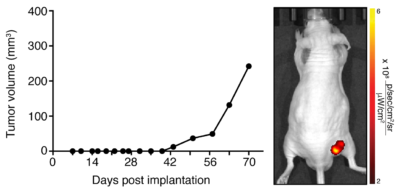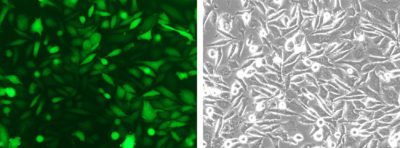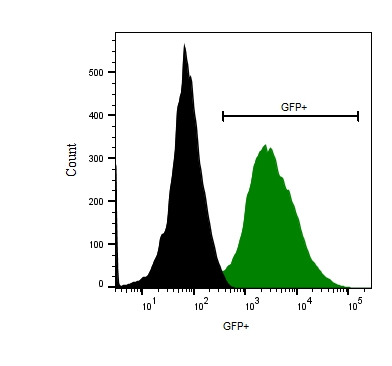PC3-eGFP-Neo
| Species | Human |
| Cell Type | Prostate |
| Transgene | Enhanced green fluorescent protein (eGFP) |
| Selection Gene | Neomycin |
-
Description
This is a polyclonal population derived from the prostate PC3 cell line (ATCC® CRL-1435TM). Parental PC3 cells were transduced with LV-eGFP-P2A-Neo (Imanis #LV067) encoding enhanced green fluorescent protein (eGFP) cDNA under the spleen focus-forming virus (SFFV) promoter linked to the neomycin resistance gene (Neo) via a P2A cleavage peptide. High eGFP expressing cells were selected using G418.
*The ATCC trademark and trade name and any and all ATCC catalog numbers are trademarks of the American Type Culture Collection.
This cell line has tested negative for mycoplasma contamination.
The parental PC3 cell line has been authenticated and certified free of interspecies cross contamination by short tandem repeat (STR) profiling.
-
Characterization
In vivo Imaging

A Nude mouse was implanted with 2.5 x 105 PC3-eGFP-Neo (CL123) cells in the right hind flank. Tumor growth was monitored over time using calipers. Fluorescence imaging was performed on Day 70 using an IVIS Spectrum.
Morphology
 Cell morphology (200x)
Cell morphology (200x)Fluorescence Expression
 PC3-eGFP-Neo (green) or isotype control (PC3 Parental; grey) cells were fixed with paraformaldehyde and analyzed by flow cytometry.
PC3-eGFP-Neo (green) or isotype control (PC3 Parental; grey) cells were fixed with paraformaldehyde and analyzed by flow cytometry. -
Growth Conditions
Complete Growth Medium: Dulbecco’s Modifies Eagles Media (DMEM), 10% fetal bovine serum (FBS), 1% Penicillin/Streptomycin, 0.5 mg/mL G418.
For maintenance, a subcultivation ratio of 1:3 is recommended. At this ratio cells will be ready for passage approximately every 3-4 days.
Cells can be amplified and used to generate additional frozen stocks. Frozen stocks should be preserved in a designated cryopreservation medium or in complete growth medium without G418 supplemented with 5-10% DMSO.
-
Usage Information
These cells are suitable for in vitro and in vivo experimentation
eGFP is not recommended for whole animal in-live imaging. Rather, samples can be collected post mortem for analysis by conventional fluorescence microscopy.
These cells were generated via lentiviral vector transduction. The lentiviral vector used for transduction was a self-inactivating (SIN) vector in which the viral enhancer and promoter have been deleted. Transcription inactivation of the LTR in the SIN provirus increases biosafety by preventing mobilization by replication competent viruses and enables regulated expression of the genes from the internal promoters without cis-acting effects of the LTR1.
-
Datasheet/COA
Lot Number CL-IM190